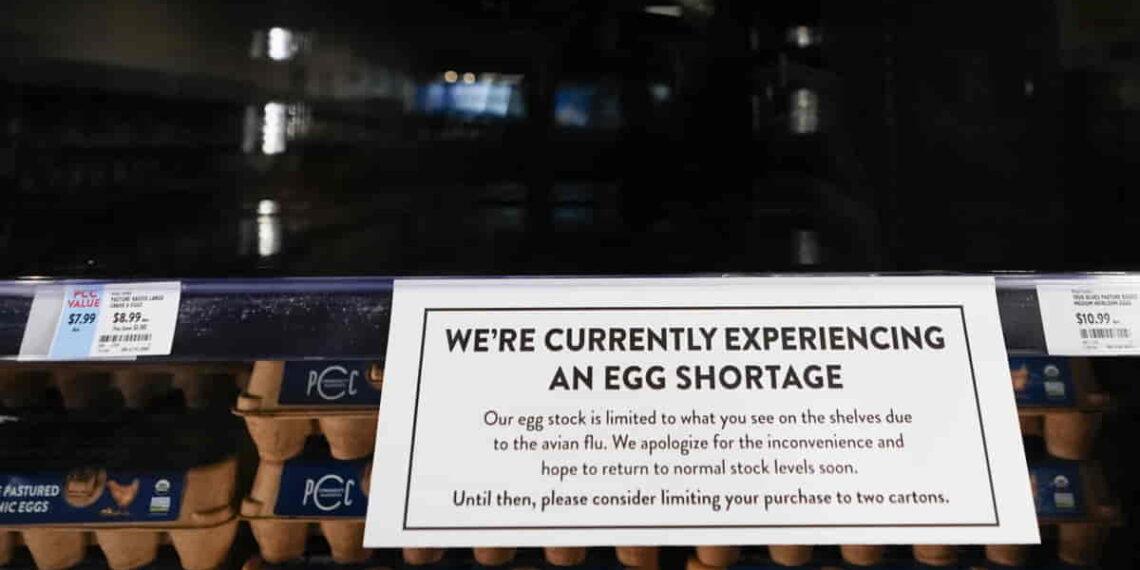Egg Prices Are Soaring—And They’re Not Coming Down Anytime Soon
Egg prices have skyrocketed, and with no relief in sight, consumers can expect to pay even more in the coming months, especially as Easter approaches and demand surges.
As of December, the average price for a dozen eggs reached $4.15 nationwide. While this is slightly lower than the record-high price of $4.82 set in 2022, experts predict that prices will rise another 20% this year. For some shoppers, the situation is even worse: prices are already more than double the national average, and many grocery stores are facing empty shelves. Organic and cage-free eggs are particularly expensive, and some stores have even implemented purchase limits.
A Staple Food Becoming a Luxury
Minneapolis resident Sage Mills shared her frustration: “It’s just robbery. Eggs used to be a staple food for us, but now you might as well just go out to eat.”
But what’s behind the surge in prices?
The Bird Flu Crisis
The ongoing bird flu outbreak that began in 2022 is the primary culprit behind the soaring egg prices. The flu spreads rapidly, and when detected on a poultry farm, the entire flock is slaughtered to prevent further contamination. With some massive egg farms housing over a million chickens, even a few cases of bird flu can lead to a severe supply shortage.
The process of dealing with outbreaks—disposing of infected birds, disinfecting barns, and bringing in new flocks—can take months. Since the outbreak began, over 145 million chickens, turkeys, and other birds have been slaughtered, most of them egg-laying hens.
In addition, the passage of cage-free egg laws in 10 states has disrupted supply chains further. These laws mandate that chickens have a minimum amount of space or be cage-free. In states like California, Massachusetts, and Michigan, the transition to cage-free eggs has pushed prices even higher. For example, at a Target in Chicago, a dozen conventional eggs was priced at $4.49, while cage-free eggs were selling for $6.19.
Why Is the Virus So Difficult to Control?
Bird flu is primarily spread by wild birds, such as ducks and geese, which carry the virus without getting sick. This allows the virus to mutate and thrive as wild birds migrate. The flu spreads easily through bird droppings or any interaction between farm-raised poultry and wild birds. It can even be brought into farms on workers’ boots or vehicles.
Unlike previous outbreaks, this one hasn’t been quelled by summer heat, as the virus found a new host in dairy cattle last March. While cattle don’t die from bird flu, their sicknesses provide more opportunities for the virus to spread. Additionally, more than 60 people have contracted bird flu since last March, with one death, though no evidence suggests it spreads from person to person.
Efforts to Combat the Virus
Farmers are taking extensive precautions to protect their flocks. Many have installed truck washes to disinfect vehicles entering the farm and require workers to shower and change clothes before entering poultry barns. Some farms even use lasers to keep wild birds away.
Additionally, dairy farmers are isolating sick cattle and performing extra testing to prevent further outbreaks. Despite these efforts, vaccination for poultry remains impractical, as it would require vaccinating millions of chickens, and many countries may refuse to buy meat from vaccinated birds.
While no bird flu-infected animals are allowed in the food supply, experts assure the public that cooking meat to 165°F (74°C) kills the virus, and pasteurization kills it in milk.
The Financial Toll
The financial toll of the bird flu outbreak has been staggering. While it’s hard to estimate how much individual farmers have spent on biosecurity measures—like sealing barns and building shower houses—the U.S. Department of Agriculture (USDA) has spent over $1.14 billion compensating farmers for lost birds. The USDA also allocated more than $576 million for its own response efforts.
The bird flu has also affected the prices of turkey, chicken, and milk, leading to further pressure on grocery bills.
At a Minneapolis supermarket, manager Mike Vickers expressed the difficulty in managing egg prices: “It’s the first time in my life that I’ve ever had to be kind of embarrassed about what I’m selling eggs for.” Despite paying $7.45 per dozen, the store is only making 14 cents on each dozen sold.
The Bottom Line
Egg prices are not likely to return to normal anytime soon. The ongoing bird flu outbreak, coupled with state laws on cage-free eggs, continues to put pressure on the supply chain. With no immediate end in sight to the crisis, shoppers will likely face higher prices, limited availability, and frustration at the grocery store for the foreseeable future.
This article was rewritten by JournosNews.com based on verified reporting from trusted sources. The content has been independently reviewed, fact-checked, and edited for accuracy, neutrality, tone, and global readability in accordance with Google News and AdSense standards.
All opinions, quotes, or statements from contributors, experts, or sourced organizations do not necessarily reflect the views of JournosNews.com. JournosNews.com maintains full editorial independence from any external funders, sponsors, or organizations.
Stay informed with JournosNews.com — your trusted source for verified global reporting and in-depth analysis. Follow us on Google News, BlueSky, and X for real-time updates.














